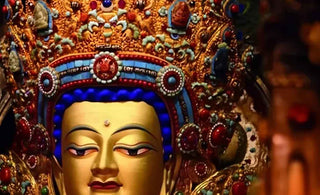
Tibetan antique statues, with their rich history and spiritual significance, are not only art but also precious artifacts that bear the weight of time. The art of restoring these treasures involves a delicate balance between preserving their original essence and repairing the inevitable signs of aging. In the realm of Tibetan Buddhist artistry, where each statue tells a story of devotion and cultural heritage, the techniques employed for preservation and repair become integral to the continuation of their legacy.
Preservation of Tibetan antique statues begins with a comprehensive understanding of the materials used in their creation. Whether crafted from metals like bronze or copper, carved from wood, or sculpted from stone, each material demands a tailored approach. For metal statues, the preservation process often involves careful cleaning to remove accumulated dust and pollutants that can corrode the surface over time. Specialized solutions that respect the integrity of the original patina are applied, ensuring that the essence of the metalwork remains untouched.
Wooden statues, susceptible to pests and environmental factors, require meticulous attention to prevent deterioration. Preservation efforts may include insect repellent treatments, climate-controlled storage, and occasional waxing to nourish the wood and protect it from fluctuations in humidity.
For instance, an exquisite 18th-century Tibetan wooden statue depicting Avalokitesvara, housed in a monastery nestled amidst the Himalayan slopes. To shield this sacred artwork from the onslaught of time, preservation efforts commence with a thorough examination to identify potential vulnerabilities. Specially formulated insect repellents, infused with traditional herbal blends known for their efficacy, are delicately applied to create an unyielding barrier against wood-boring pests. The climate-controlled storage chamber, carefully calibrated to maintain optimal humidity levels, becomes a sanctuary for the statue. This controlled environment shields the wood from the extremes of weather, preventing the expansion and contraction that can lead to cracks and warping. As a ritualistic practice, the statue undergoes a periodic waxing, where a blend of locally sourced beeswax and natural oils is applied. This nourishing concoction not only bestows a subtle luster upon the wooden surface but also acts as a protective seal, shielding the statue from the subtle shifts in humidity within its sacred abode.
In this way, the preservation endeavors become a holistic ritual, intertwining traditional wisdom with contemporary conservation practices, ensuring that the wooden masterpiece retains its spiritual resonance and aesthetic allure for generations to come. Stone statues, carved with precision, benefit from regular inspections to identify and address any cracks or erosion that may compromise their structural integrity.
The repair of Tibetan antique statues is a delicate art that demands both technical skill and a profound respect for the original craftsmanship. In cases where metal statues exhibit signs of corrosion or damage, skilled artisans employ techniques such as soldering and patching. Sensitive to the aesthetic nuances of the statue, these repairs are conducted with a discerning eye, ensuring that the integrity of the original design is maintained.
Wooden statues that have suffered from insect infestations or natural wear may require careful patching and, in some cases, the replacement of missing or irreparable parts. The choice of wood for these repairs is crucial, with artisans often sourcing materials that closely match the original in species, color, and grain. The goal is not just to mend but to seamlessly integrate repairs, allowing the statue to tell its story without betraying the passage of time.
Stone statues, although enduring, can succumb to erosion and weathering. Preservation efforts often involve stone consolidation to strengthen weakened areas and the careful filling of cracks or missing sections. The challenge lies in harmonizing the repaired portions with the original stone, ensuring a cohesive aesthetic that honors the statue's intrinsic beauty.
In the world of Tibetan antique statues, the art of restoration extends beyond technical proficiency. It embodies a profound understanding of the cultural and spiritual significance these artifacts hold. The artisans engaged in restoration work often immerse themselves in the spiritual context of the statues, recognizing that each repair is not just a physical mending but a continuation of the sacred narrative.
The techniques used in the restoration process are passed down through generations, creating a lineage of expertise that respects the traditions of Tibetan artistry. The knowledge of ancient methods, combined with modern conservation practices, forms a comprehensive approach to ensure the longevity of these cultural treasures.
The commitment to preserving and repairing Tibetan antique statues goes beyond the confines of restoration workshops. It extends to the communities and institutions that house these artifacts, with proper storage conditions, climate control, and preventive measures playing pivotal roles. Collaborative efforts between conservationists, curators, and artisans ensure a holistic approach to safeguarding the legacy encapsulated in each statue.
Conclusion
In conclusion, the art of restoring Tibetan antique statues is a multidimensional endeavor that merges technical skill with cultural stewardship. As these statues traverse the currents of time, the delicate hands of skilled artisans guide them through the currents of preservation and repair, ensuring that their resplendent stories continue to be told for generations to come.
























